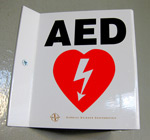
The Next AED?
- By Jerry Laws
- Dec 01, 2009
Almost every workplace has a fire extinguisher. Quite a few are equipped with automated external defibrillators. A few suppliers of emergency oxygen units and kits are hoping to see those products someday gain a foothold comparable to AEDs, and possibly even comparable to extinguishers.
"Sales are difficult now because properties still don't view this as federally mandated because it's not an OSHA requirement," said Vic Fetterman, general manager of Buckeye CPR & First Aid (www.buckeyefi rstaid.com) of North Olmsted, Ohio. He said Buckeye, owned by Sandy Varga, has been selling one manufacturer's emergency oxygen unit for about a year throughout Ohio. If OSHA ever decreed AEDs and emergency oxygen units should be placed in industrial plants above a certain square footage, sales would leap, Fetterman said Oct. 8.
The victim "doesn't have to be having a heart attack; it could be almost any serious trauma. They [rescuers] always give you oxygen. Even for the smaller things, they strap the oxygen on you," he said. "Where would these be needed? We think they're needed any place you need a fire extinguisher, especially if the extinguisher is mandated by OSHA."
Frank Robb, safety coordinator for Jersey Precast Corp., said he had six oxygen units installed in the company's three plants in August, and those six units are indeed stationed beside fire extinguishers. "We have 225,000 square feet of space under roof. Putting one in each plant would be a waste of time, so I put one in each end of the plant," he said Oct. 6.
These are FDA-regulated devices that must provide at least 15 minutes of continuous oxygen flow at a rate of 6 lpm. A physician's prescription is not required because these devices are exempted for emergency use by properly trained personnel.
Once the devices were in place, Robb and the company's safety personnel held a meeting with the employees to discuss how the units function and when they should be used. The employees haven't used them yet but appreciate having them nearby, Robb said. Some workers in each plant are designated as fire and emergency responders, and the workforce regularly receives evacuation, extinguisher, and first aid training delivered in Spanish.
"We have cuts and bruises, things like that, but so far this year I have no lost-time accidents," he said. "If I go to November 15 of this year, I'll have no losttime accidents in this plant. We have approximately 220 people in this [Hamilton, N.J.] plant. I instituted a light duty program when I first got here for the sole purpose of bringing our insurance rates down. It was kind of heft y when I came on. I brought it down, and we're doing pretty well."
He initially saw the units earlier this year, when a welding supplies vendor stopped in with the product and said he would be the provider filling up the oxygen cylinders. "I'd never seen anything like it," Robb said. "We had a problem at one of the other plants where I worked — we needed it [emergency oxygen] for somebody. Just thank God that one of the guys who worked for me was a volunteer fireman who had emergency oxygen in his truck."
Robb said the victim in that other plant had suffered a heart attack or stroke. "Somebody told me ambulances carry something like this for emergencies. I said, 'We ought to start having this in our plants.'
"I kept thinking of that and thinking of that and thinking of that. And I ran it by some people who said they'd never heard of it. Firetrucks carry it, and ambulances, and police vehicles, but I'd never heard of a version for the public like this." So he decided to buy them. Robb has talked with insurers who said a discount is possible for having the units installed in the plants; he also has a unit in his home and has given three to neighbors.
Jersey Precast manufactures Jersey barriers for highway work and precast, pre-stressed concrete panels that are used in bridges, highways, dams, stadiums, and buildings. The company recorded 11 lost-time employee accidents last year and 22 minor incidents, such as lacerations and pinched fingers. At the time of our interview, only eight minor incidents had occurred, Robb said.
Low Cost, High Value
Fetterman said he's not heard that any of the oxygen units sold by Buckeye has been used to this point, but he said Buckeye might not know in any case because another company would be called to refill a used cylinder. The units cost $250 to $300 each, he said.
Estimates are 250,000 to 350,000 people die of sudden cardiac arrest annually in the United States, and some of those victims could be helped with an AED and emergency oxygen. Yet SCA attracts little attention among the general public.
Th ink of the numbers in terms of three large stadiums filled with professional football fans, Fetterman suggested. "If that many people died in one location at one time, that would be a national, an international, catastrophe," he said. "If everybody who died last year died on the same day, that would have some dramatic impact."
This article originally appeared in the December 2009 issue of Occupational Health & Safety.